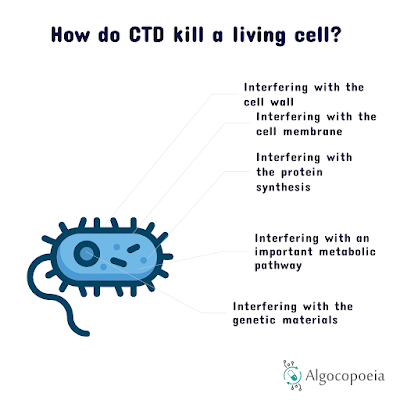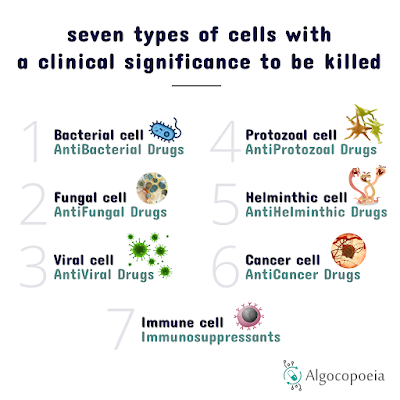
- Chemotherapeutic Drugs (CTD) are not just those which are used to treat cancer.
- Almost, everyone has already used CTD, or maybe they are using them nowadays - Your antibiotic and antiviral are both CTD.
- Moreover, your COVID-19 vaccine is considered to be a CTD.
What are CTD?
Chemotherapeutic Drugs (CTD): are drugs which have the ability to kill or interfere with a specific living cell. This cell could be any type of living cells - Not just a cancer cell.
Seven types of cells with a clinical significance to be killed:
1. Bacterial cell - AntiBacterial Drugs
2. Fungal cell - AntiFungal Drugs
3. Viral cell - AntiViral Drugs
4. Protozoal cell - AntiProtozoal Drugs
5. Helminthic cell - AntiHelminthic Drugs
6. Cancer cell - AntiCancer Drugs
7. Immune cell - Immunosuppressants
So, all of the seven mentioned drugs are considered to be CTD.
How do CTD kill a living cell?
1. Interfering with the cell wall
2. Interfering with the cell membrane
3. Interfering with the protein synthesis
4. Interfering with the genetic materials
5. Interfering with an important metabolic pathway

Theoretical model: Imagine that you’re dealing with a new type of cancer, to produce a new drug to treat it you should:
1. Study the full profile and characteristics of the five mentioned targets for your cancer - so you have sub-targets: Cell wall, cell membrane, protein synthesis, genetic materials & metabolic pathways.
2. Target the most suitable sub-target: Specific (not to cause harm to the host) - taking into account any other factors (economic, industrial … etc.).
References
BOOKS
- Lippincott Illustrated Reviews: Pharmacology - 7th Edition
- Katzung & Trevor's Pharmacology Examination and Board Review - 12th Edition
- Basic and Clinical Pharmacology - 14th Edition



Post a Comment